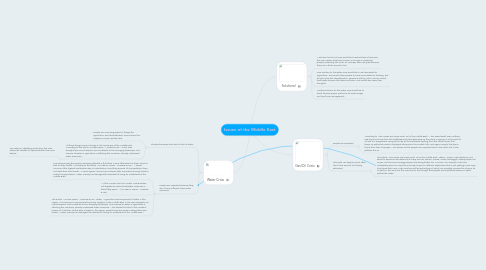
1. Water Crisis
1.1. Climate becomes drier due to lack of water.
1.1.1. People are overusing water for things like agriculture, and desertification occurs when this happens on poor quality land.
1.1.2. All these things cause a change in the landscape of the Middle East. According to the article WATER CRISIS - MIDDLE EAST, "In the area droughts are more frequent, and contribute to the changing landscape. The overuse of water in agriculture is affecting the countries' already undersized water resources."
1.1.2.1. For instance, depleting water from the area allows the deserts to expand farther than ever before.
1.2. People are impacted because they don't have sufficient clean water resources.
1.2.1. One obvious way the people are being affected is that there is very little water for them, which is bad for their health. According to the article "WATER IN CRISIS - MIDDLE EAST", " Yemen has one of the highest worldwide rates of malnutrition; over thirty percent of its population does not meet their food needs . In recent years, Yemen has not been able to produce enough food to sustain its populations. Water scarcity has damaged the standard of living for inhabitants of the Middle East."
1.2.2. "At this current rate, the United Arab Emirates will deplete its natural freshwater resources in about fifty years." (-WATER IN CRISIS - MIDDLE EAST)
1.2.3. The article "WATER CRISIS - MIDDLE EAST" states, "Agriculture uses 85 percent of water in this region. It is common to misuse land by heavy irrigation in the Middle East. In the area droughts are more frequent, and contribute to the changing landscape. The overuse of water in agriculture is affecting the countries' already undersized water resources." This shows that due to the constant misuse of (a fraction of) the 85% of water in the region, people have less water, making their lives harder. "Water scarcity has damaged the standard of living for inhabitants of the Middle East."
2. Solutions!
2.1. A solution for the oil crisis would be to extract less oil because the main reason why there is even a oil crisis is caused by people extracting too much oil. Perhaps take new jobs because there are a finite amount of oil.
2.2. One solution to the water crisis would be to use less water for agriculture. This would allow people to have more water for drinking. But to try to stop the desertification, people could try not to use up natural fresh water sources like lakes and rivers. This would also cause less droughts.
2.3. Another solution for the water crisis would be to teach farmers proper protocols for water usage and land/crop management.
3. Gas/Oil Crisis
3.1. People are impacted
3.1.1. According to "The Haves and Have-Nots: Oil in the Middle East", "The sweet smell over northern Iraq does not come from the wildflowers that are blooming on the plains in spring. It is the smell of oil and it is everywhere, rising to the sky at the wellheads, spilling from the tanker trucks that bump up potholed roads to backyard refineries in the Kurdish hills, and again rising to the sky as fumes from their chimneys." This shows us that people are impacted due to the smell, but it also pollutes the air.
3.2. Oils spills can happen more often due to the amount of it being extracted.
3.2.1. The article "The Haves and Have-Nots: Oil in the Middle East" states, "Poorer Arab states are not about to become new Qatars, but many, such as Yemen, Tunisia, Sudan and Egypt, already export oil or gas, and the some energy paupers are doing better too. Morocco, for example, until now completely reliant on imports, pins high hopes on offshore exploration that is just getting under way." This shows that more Arab countries will be extracting oil, which can possibly increase the chance for oil spills in the area, but this connects to the thought that people are impacted because oil spills pollute the water.

